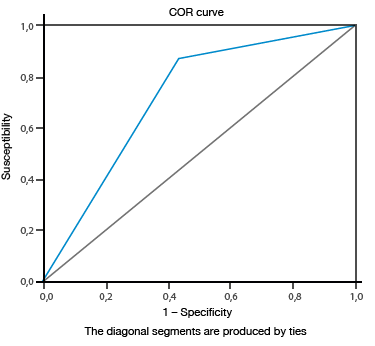Introduction
Syncope is a major syndromic complex which supposes great challenge for diagnosis and therapy to health personnel in charge of patient care. The importance of the initial study, and short and medium term risk assessment, lies in the difference between the relatively benign causes represented by vasovagal episodes and potentially fatal causes in a short period of time, such as conditions secondary to cardiovascular disease 1.
The economic burden, both direct and indirect, is highly relevant; this cost is primarily represented by intra-hospital expenses generated by the decision to hospitalize a patient with syncope, decision often unnecessarily taken by fear or lack of knowledge from health personnel about the life-threatening event. A new study finds that in a university hospital, 100% of patients admitted to the emergency room due to syncope were hospitalized 2; however, if early and medium term risk identification tools are used, lower costs can be achieved through outpatient management 3.
Literature shows that multiple works have been developed on risk stratification scores, most of them obtained from the emergency department for short-term prognosis. Some of them, like the San Francisco Syncope Rule (SFSR), the Boston Syncope Rule, Oesil, Steps and Egsys, have shown deficiencies mainly when attempting external validation, exposing different results 4,5. This study evaluated the ROSE risk score diagnostic performance in a cohort of patients admitted for syncope to the emergency room.
Materials and methods
All patients older than 18, who attended the emergency rooms of Fundación Hospital San Carlos and Fundación Santafé de Bogotá due to syncope, between August 2013 and February 2014, were included.
Syncope is defined as a transient altered state of consciousness and postural tone with spontaneous recovery without neurological deficit (except for amnesia after the event).
We excluded patients with loss or alteration of consciousness that was not secondary to transient cerebral hypoperfusion (consumption of alcohol or hypoglycemia), with head trauma presented before the syncopal episode, with a known history of epilepsy -typical seizure episode or prolonged postictal seen or described by witnesses- and persistent neurological deficit suggestive of acute vascular brain attack or transient cerebral ischemia.
The study was approved by the ethics and research committees of the two institutions involved and patients signed an informed consent to participate. Follow-up was conducted through the review of medical records, if the patient was hospitalized during the follow-up period or by telephone, if the patient had been discharged. A descriptive analysis of demographic characteristics, data specific to the syncopal event, history, physical examination and paraclinical exams requested at admission was made.
The following were considered as adverse outcomes: death, acute myocardial infarction, need for percutaneous or surgical coronary revascularization, severe aortic stenosis, aortic dissection, cardiac tamponade, pulmonary embolism, dilated cardiomyopathy with a left ventricular rejection fraction of <35%, diagnosis of major bradyarrhythmias and electrotherapy -pacemaker implant, pauses longer than three seconds, 2:1 AV Block, Type II Mobitz AV block, complete AV block, bradycardia under 30 bpm, alternating bundle branch block, pacemaker malfunction related to capture fault-, diagnosis of tachyarrhythmia -ventricular or sustained supraventricular tachyarrhythmia-, defibrillator implant, cardiac resynchronization therapy device implant, malfunction of cardioverter-defibrillator or cardiac resynchronization therapy device due to inadequate treatment of sustained ventricular arrhythmias, significant bleeding -need for transfusions, endoscopy requiring endoscopic treatment due to bleeding or need for surgical intervention due to bleeding-, lesions after the syncopal event that could affect life -head trauma, spinal fracture or long bones- and emergency readmission.
The description of all the variables that make up the ROSE score was made for each patient: abnormality of electrocardiogram (presence of pathological Q waves, except for Lead III), presence or absence of anemia (HB ≤9 g/dl), bradycardia (heart frequency ≤50 lpm), abnormal rectal examination when gastrointestinal bleeding was suspected, chest pain with syncope, abnormal brain natriuretic peptide (BNP) (≥300 pg/ml) and oxygen saturation abnormal to the environment (<94%).
All causes and major cardiovascular adverse events were considered as primary outcomes, while events such as mortality and independent major adverse events were considered as secondary outcomes.
A univariate analysis was conducted according to the nature of the variables: qualitative variables are presented with absolute numbers and proportions, while quantitative variables are presented with measures of central tendency (average) and statistical dispersion (standard deviation). A Kolmogorov-Smirnov test was performed to define the statistical tests that would be used for bivariate analysis and whether quantitative variables followed a normal distribution. For the prediction of the primary outcome at 7 and 30 days, the operating characteristics of the test were evaluated, sensitivity, specificity, positive predictive value (PPV) and negative predictive value (NPV). Data were analyzed through the SPSS V19 program.
Results
During the August 2013 - February 2014 period, 60 patients were selected. The average age was 66.47±20.3 and 56.7% (n=34) of the population were females. Demographic characteristics are shown in Table 1.
Table 1 Demographic characteristics of the study population.
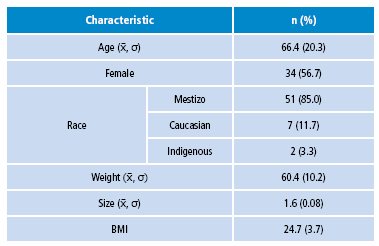
: average; σ: standard deviation; BMI: body mass index. Source: Own elaboration based on the data obtained in the study.
In this population, 31.7% (n=19) had previous syncopal events; of these, 42% (n=8) registered a single syncopal event in the last six months, 15.8% (n=3) two episodes and 36.9% (n=7) three or more episodes. Other frequent antecedents were previous heart disease (25%) and heart failure diagnosis (21.7%) (Table 2).
Table 2 Medical history of the study population.
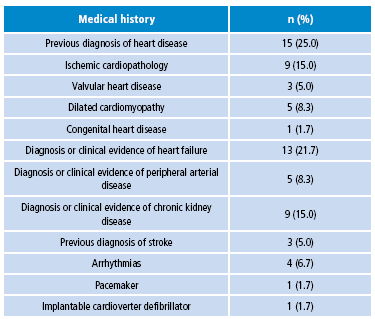
Source: Own elaboration based on the data obtained in the study.
The characteristics of the syncope episode commonly showed prodromal symptoms (51.7%) and dyspnea (36.7%). The average time elapsed between the time of syncope and consultation to the emergency department was three hours (RIQ=1.87-16.25). The average hospital stay for the study of syncope and management of complications was 8.9 days (0.5 to 60) (Table 3).
Table 3 Characteristics of the syncope episode of the study population.
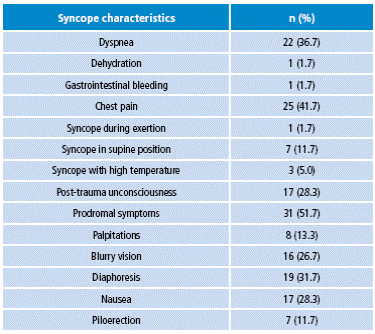
Source: Own elaboration based on the data obtained in the study.
The physical exam at admission found mainly: systolic blood pressure of 125.1±23.3 mmHg, diastolic blood pressure of 72.5±13.7 mmHg, heart rate of 68.5±17.7 bpm, respiratory rate of 19.6±9.5 rpm and oxygen saturation of 90.05±12.4%. Electrocardiogram at admission found alterations in 76.7% (n=46).
The main abnormal electrocardiographic findings were: non-specific changes in ST-T (54.3%), axis deviation (34.8%), sinus bradycardia (32.6%), left ventricular hypertrophy (30%), intraventricular conduction block (26%) and atrioventricular block (15%). 10.9% of patients had a pre-excitation pattern; the corrected mean of the QT interval was 412ms (normal). Within laboratory data taken on admission to the emergency unit, the obtained values of the variables that are part of the ROSE risk score were taken into account. 40% of the study population (n=24) showed values greater than or equal to BNP 300 pg/ml (abnormal) with a median of 524.5 pg/ml (225.75-1727). Regarding hemoglobin, the average was 13.7 g/dl.
The incidence of the outcome at 7 and 30 days of follow up was 40% (n=24) and 8.3% (n=8), respectively (Table 4). 80% (n=40) of patients had a high risk score at admission, and 31.2% of them had an adverse outcome. All patients with a composite outcome between at 7 and 30 days already had such outcome before 7 days had passed. The association evaluated with a Pearson's chi-squared test was 1.522 with p=0.217.
Table 4 Outcomes at 7 and 30 days of follow-up.
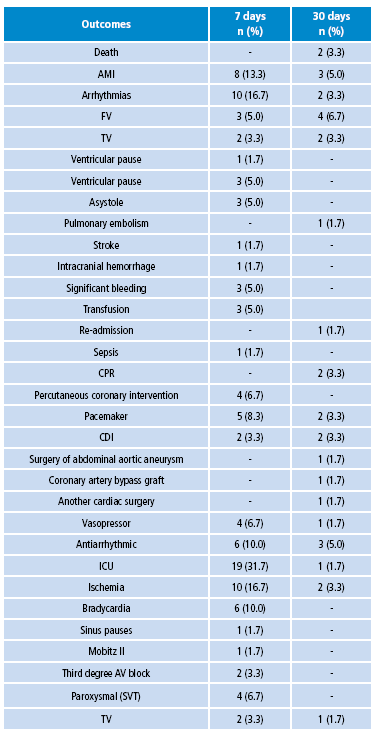
Source: Own elaboration based on the data obtained in the study.
Within components of ROSE risk score, 2 (3.3%) had fecal occult blood, 2 (3.3%) anemia (Hb≤9 g/dl), 24 chest pain (40%), 7 (11.7%) Q waves in EGG, 24 (40.7%) BNP>300 pg/mL, 15 (25%) bradycardia (<50lpm), and 39 (65%) SaO2<94%.
There was no loss of follow-up at 7 or 30 days. For prediction of primary outcome -major, serious and death-, the ROSE risk score showed sensitivity, specificity, PPV and NPV of 60%, 18.18%, 6.25% and 83.33% respectively. The area under the ROC curve was 0.62 (95%CI: 0.45 to 0.78) (Figure 1 and 2).
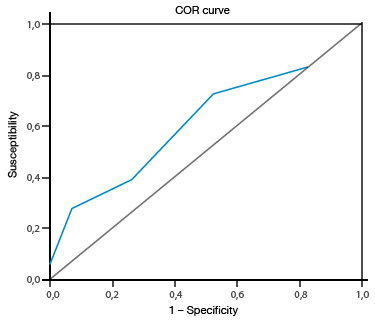
Figure 1 Curve of operating characteristic of the receiver of the ROSE scale for composite outcome at 7 days. Source: Own elaboration based on the data obtained in the study.
Discussion
The main finding of this study is that the ROSE risk score did not have adequate performance for prognosis in this Colombian cohort to find sensitivity, specificity, and low VPP for mortality and major events.
When comparing populations with syncope in this study with those of the original study by Reed et al.6, it is possible to see that, in both, the average age was 65 and that patients had a higher prevalence of cardiovascular comorbidities and similar risks of greater complications. A striking difference found in this research is a lower prevalence of previous history of syncopal episodes compared to the original study (32% vs. 43%).
Previous history of syncope could represent more unidentified or previously unstudied cardiovascular comorbidity; however, as there are people with recurrent or frequent syncope, the neurally mediated mechanism or reflection is the most associated with these episodes and generates better prognosis and lower incidence of ominous events. In addition, patients present with higher prevalence of heart failure (21.7% vs. 5.1%) and high risk of sudden death; this important difference may explain the high prevalence (68%) of high BNP (>300 pg/ml) and why this population is sicker from a cardiovascular standpoint; however this is against adequate ROSE sensitivity rule.
The history of coronary artery disease -previous myocardial infarction- was also higher (15% vs. 10%), although it was not significant. In the original study, the cause of syncope was identified in the emergency department in 44% of cases, compared to what was found here, where most patients were hospitalized mainly due to uncertain diagnosis and short term prognosis.
76% of patients in this study had an abnormal electrocardiogram (ECG) on admission, ranging from subtle abnormalities to signs of significant structural heart disease; in contrast, the study of Reed et al.6 found that 96% of patients had an ECG in sinus rhythm with no major abnormalities on admission.
The follow-up after one year of the cohort of patients who underwent the ROSE score allowed finding that 52% of the events were manifested after the first 30 days of evaluation. Sensitivity decreased while specificity increased (71.6% and 71.1%, respectively), which is a typical behavior of a diagnostic test with greater statistical power 7 and which leads to infer that the scale loses performance as the index event progresses.
It is important to assess the need for external validations since other scores found lower prognosis yield. Thus, e.g., Saccilotto et al.8 conducted a systematic review that assessed 12 studies that used the San Francisco scale; in this study, the sensitivity and specificity of the scale varied considerably in relation to the original derivation -sensitivity of 87% and specificity of 52% in the systematic review, and sensitivity of 96% and specificity of 62% in the derivation-. Similarly, the external validation of this scale showed distant values (sensitivity 89% and specificity 69%). As a consequence, it can be said there are specific factors of the population that make risk scales have a different behavior 9,10.
The high negative predictive value of the ROSE scale (83%) must be emphasized, which would make this score a useful tool in low-risk patients. All patients experiencing an outcome until day 7 had no new events at 30 days, which reflects the need to broaden the sample of patients with syncope.
Prior to using BNP as a variable of cardiovascular adverse outcome with a risk score as ROSE, its usefulness as an independent risk factor in patients with syncope had already been evaluated. In the study of Reed et al.11 the value of BNP for predicting adverse outcomes at three months in adult patients with syncope events was evaluated, finding that a value of 100 lpg/ml was more sensitive than that found in institutional risk prediction guides at three months of follow-up with similar specificity. It is likely that BNP is not useful for predicting outcomes in low risk groups, although no assessment of the issue is found. In this same study, more than 40% of patients had a BNP value greater than or equal to 300 pg/mL, representing a large sample of high risk patients for post-syncopal cardiovascular complications.
D'Ascenzo et al.12 evaluated 43 315 patients with syncope and determined that 10.4% had underlying cardiac abnormalities, being bradyarrhythmia the most common (4.8%); this is far exceeded in this study, where bradyarrhythmia was the third most frequent electrocardiographic finding (32.6%), preceded by axis deviation and changes in ST segment and T wave.
An important limitation when considering the use of a serum marker for damage or myocardial overload, as in the case of BNP in the assessment of the prognosis of patients with syncope, is based on the fact that BNP itself could be identified only in older patients, with higher prevalence of structural heart disease and heart failure, diseases that imply a worse prognosis and increased incidence of cardiovascular complications. However, this measurement represents a more objective marker of heart disease or cardiac involvement from another source compared to a medical history and, a much more subjective, physical examination.
Regarding the general limitations of the study, the most important is sample size, followed by the high variability reported in the reading of the electrocardiogram, which may vary depending on the observer's experience. This makes a reliable standardized reading of these studies necessary, since the detection of electrocardiographic abnormalities allows the identification of patients with cardiogenic syncope, the main etiology associated with increased morbidity and mortality. Similarly, the follow-up time (30 days) can be considered minimal, because it limits the detection of long-term events.
Conclusions
Given the low calculated sensitivity and the small sample of patients, the ROSE risk score does not have a good diagnostic performance as a predictor of major cardiovascular outcomes and death at 30 days in the study population. Nevertheless, all patients with a low risk score (0) could be assessed on an outpatient basis given the high NPV.
The authors of this document express that its content derives from a research project (degree project) conducted by the Department of Internal Medicine from Universidad Nacional de Colombia and authored by Manuel Agustín Paz Meneses 13.













